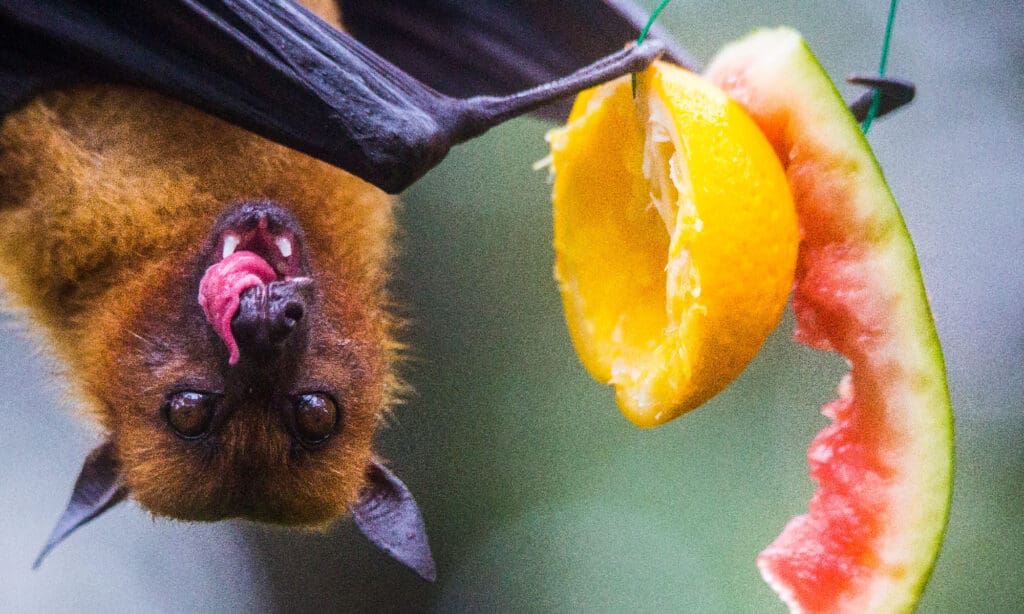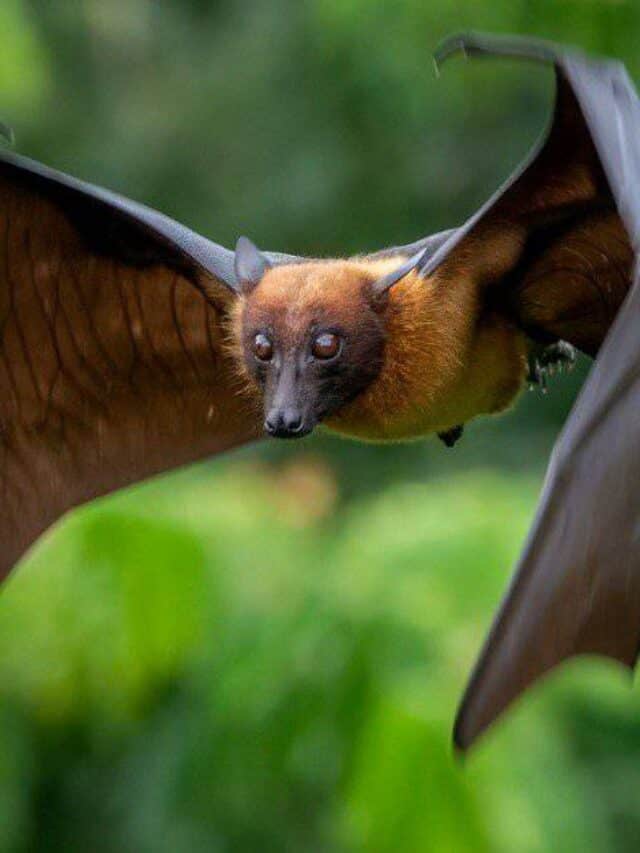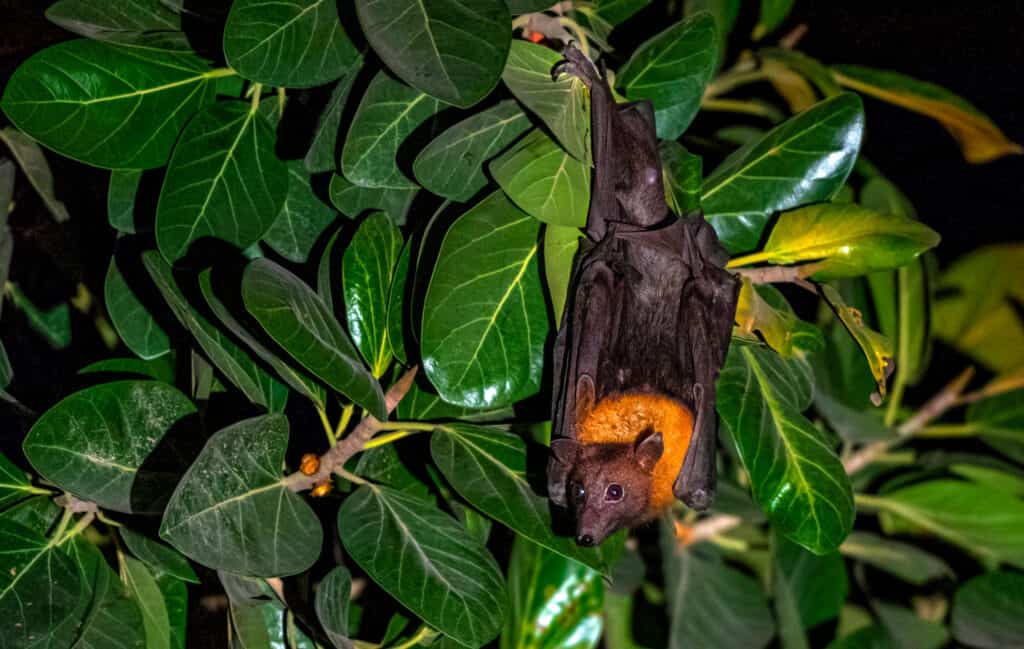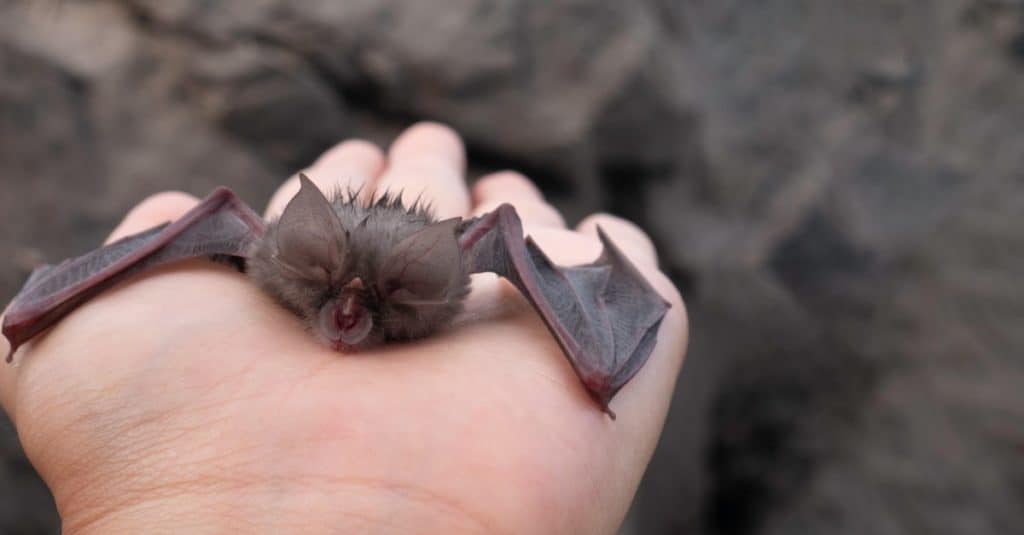Fruit Bat
Among the largest bats in the world
Advertisement
Fruit Bat Scientific Classification
Read our Complete Guide to Classification of Animals.
Fruit Bat Conservation Status
Fruit Bat Facts
- Name Of Young
- Pups
- Group Behavior
- Colony
- Fun Fact
- Among the largest bats in the world
- Estimated Population Size
- Unknown
- Biggest Threat
- Habitat Loss
- Most Distinctive Feature
- Wings
- Other Name(s)
- Flying Foxes
- Gestation Period
- 4-6 months
- Litter Size
- 1-4 pups
- Habitat
- Forests and savannas
- Predators
- Snakes, lizards, birds, and mammals
- Diet
- Herbivore
- Favorite Food
- Fruits, pollen, nectar, and more
- Type
- Mammal
- Common Name
- Fruit Bat
- Location
- Africa, Asia, and Australia
Fruit Bat Physical Characteristics
- Color
- Brown
- Grey
- Black
- Skin Type
- Hair
- Lifespan
- 30years
- Weight
- Up to 1.4kg (3.1lbs)
- Length
- Up to 32cm (13in)
- Age of Sexual Maturity
- 2 years
- Age of Weaning
- A few months
View all of the Fruit Bat images!
The fruit bat is a large taxonomical family of related species, mostly originating from the tropical and subtropical areas of Africa and Asia.
The fruit bat spends much of its time hanging upside down in trees or caves with other members of the same species. They are aptly named for their habit of feasting exclusively on fruits and plant parts. However, many species are currently endangered by hunting and habitat loss.

4 Incredible Facts!
- The bat is an exquisitely talented flyer. In fact, it is the only mammal fully capable of flight.
- These bats have an unfortunate tendency to incubate viruses and other diseases.
- While the fossil record of the fruit bat is sparse, genetic analysis reveals that the ancestor of all fruit bats probably evolved more than 30 million years ago.
- One of the more amazing facts is that fruit bats play an important role in their local ecosystem by dispersing undigested seeds or pollen throughout the environment. Some plants have even evolved unique adaptations that make it easier for bats to feed. This mutually beneficial adaptation is an example of a symbiotic relationship.
Scientific Name

The scientific name for the fruit bat is Pteropodedae, which means wing-foot.
©Natalia Golovina/Shutterstock.com
The scientific name for the family of fruit bats is Pteropodidae (this is derived from a combination of Latin words that roughly translate to mean “wing-foot” in English). This family is also sometimes known as megabats, flying foxes, and Old World fruit bats. However, it is possible to define fruit bats more broadly than this. It can mean basically any bat that consumes fruit. By this definition, there are several more species within the family of New World leaf-nosed bats (scientific name Phyllostomidae). As the name suggests, the New World leaf-nosed bats reside in the Americas. They have therefore evolved very different physical and behavioral traits compared to their cousins in the Old World Pteropodida family.
Evolution

The Guam flying fox (Pteropus tokudae), also known as the little Marianas fruit bat, was a tiny megabat from Guam in Micronesia.
©Jon Irvine / CC BY-SA 2.0 – License
Regardless of their size, bats have an undeserved bad reputation. Apart from being linked with vampires, they are wrongfully labeled as “flying rats” and accused of transmitting zoonotic illnesses to humans. Despite this fear, it’s remarkable that bats are the sole mammals to possess the ability of powered flight, and they have been soaring in the sky for countless millions of years. So, where did these strange flying creatures originate?
Fossils of bats have been discovered in various locations around the world, dating as far back as 50 million years ago during the Eocene Era. Paleontologists have found evidence such as jaw fragments, teeth, and complete skeletons. Compared to their modern counterparts, these ancient bats did not have the ability to echolocate and had claws on all five fingers. Recently, technology has revealed that two 48 million-year-old bats were mostly brown in color.
Scientists are still pondering the origin of fruit bats. It has been suggested that early bats may have lived in forests. However, their remains are rarely found due to these environments not being suitable for preservation. On the other hand, modern bats living near lakes have been well-preserved due to the fine sediment and oxygen-depleted water in these areas that allowed fossils to be quickly buried away from scavengers and other decomposers.
In order to understand when bats first came into existence, their evolution to fly, and more, scientists need to discover more sites from rocks that are between 50 and 66 million years old. Examining living mouse-tailed bats is the closest paleontologists can get to understanding the early proto-bat. We can hypothesize that bats had fur and went through a gliding stage before a powered flight, and their diet likely consisted of insects. However, without a reasonably complete fossil, this is all speculation.
Fruit bats have been evolving for over 50 million years, with their origins likely stemming from the extinction of non-avian dinosaurs some 66 million years ago. Scientists expect to find fossils of the early stages of bat development in the same period when a mysterious group of mammals began to fly.
Species
The Old World Pteropodidae family contains more than 170 different species across 42 different genera. The largest genus is known as Pteropus, which contains some 59 species alone, including the Indian flying fox, Rodrigues flying fox, the little red flying fox of Australia, and many others scattered throughout the Pacific Islands. Other well-known species include the Egyptian fruit bat, the hammer-headed bat, and the Buettikofer’s epauletted fruit bat of Western Africa.
Appearance

Egyptian fruit bats are brown with soft fur.
©Rosa Jay/Shutterstock.com
Despite being the only mammal capable of full flight, the fruit bat has many hallmarks of mammalian ancestry, including the long coat of fur and the ability to produce milk. Even the wing membranes are just extended flaps of skin. However, there are many defining features of a fruit bat, such as the relatively large eyes, the simple erect ears, the canine-like face, two upper and lower canine teeth, and a big rostrum (the beak-like part extending from the nose).
Some species possess all manner of unique accouterments. The tube-nosed fruit bats, for instance, have tube-shaped nostrils that project from the snout. The aptly named hammer-headed bat has a large, blunt snout that’s shaped conspicuously like a hammer. The Franquet’s and Buettikofer’s epauletted fruit bats of Africa have scent glands on their shoulders decorated with small tufts of white fur for social purposes (the word epauletted literally means a type of decorated shoulder pad).
Another defining feature of these animals is their large size. While a few species measure only a few inches from head to tail, fruit bats are, on average, the largest type of bats in the world. The impressive large flying fox has a remarkable wingspan of approximately 5.5 feet, or the size of some people. The shape of the wings seems to be tied directly to the body size. Smaller fruit bats have shorter wings that enable them to maneuver very well while flying under canopies. Larger fruit bats have longer and narrower wings that enable them to fly for longer periods of time over immense distances. Males tend to be larger than females on average. When physical differences exist, the males are more likely to have unique appearances, while the female has a more typical fox-like appearance.
Behavior

Bats are the only mammals that can fly in a sustained fashion.
©Independent birds/Shutterstock.com
One of the bat’s defining traits is their nocturnal nature; they come out at night between the dusk and dawn hours to feed. Fruit bats are no different. Only a few species buck this trend and feed during the day. Many potential reasons have been hypothesized to explain the bat’s nocturnal behavior, but the most likely explanation is that the bat is trying to avoid predators. The few species that do regularly venture out during the daylight hours appear to be free of predatory pressures.
Despite sharing this nocturnal behavior with their bat cousins, fruit bats are unique in many respects. They are the only family of bats that regularly rely on their sense of smell and vision rather than echolocation (the animals’ “sonar” system) to perceive the world around them. Only a few species of fruit bats are actually capable of simulating a crude form of sonar through the use of tongue clicking. However, it is unclear whether the fruit bats lost the echolocation ability in the distant past or simply never evolved it in the first place.
These bats tend to be among the most sociable of all mammals. With the exception of a few solitary species, their social arrangement usually revolves around large groups of up to 200,000 individuals. The size of the group may be related to the availability of local food supply. In places where food is more common, bats will congregate in huge numbers.
While a few species migrate immense distances with the advent of the seasonal rains, most of these animals remain near the same roosting site for much of their lives. These roosts are a cacophony of different sounds and noises, such as squeaking, bleats, and trills. At least one species, the Egyptian fruit bat, has the ability to learn from other individuals and alter their vocalizations, which gives rise to a kind of local dialect.
Habitat

Fruit bats nest in trees, caves, bushes, and buildings. If undisturbed, they will keep the same roost for life.
©thsulemani/Shutterstock.com
The tropical or subtropical forests and savannas of the Eastern Hemisphere, spanning between the Eastern Mediterranean and Australia, contain all the fruit bat species from the family of Pteropodidae. A few more species unrelated to this family can be found in Central and South America. More than half of the fruit bats roost in trees; the rest inhabit caves, rocks, bushes, and even buildings. If left undisturbed, they have shown the ability to use the same roost site for decades.
Predators and Threats

The largest threat to fruit bat’s survival is humans
©Janelle Lugge/Shutterstock.com
Besides the threat of natural predators, the three greatest dangers to the fruit bat’s existence are habitat loss (which destroys its roosting site and food sources), deliberate poisoning or shooting by farmers (to prevent them from raiding crops), and overhunting for their meat. Habitat degradation is further exacerbated by the looming threat of climate change.
What eats the fruit bat?
These animals are preyed upon by some snakes, lizards, birds of prey, and carnivorous mammals, including humans.
What does the fruit bat eat?
These animals are entirely dependent on flowering plants for their survival. They spend most of their time foraging for a rich selection of fruits, pollen, and nectar. In order to feed, the bat will squeeze out the juice from the fruit with its teeth and leave behind the fleshy parts uneaten. Each species of fruit bat demonstrates a tendency to favor specific plants based on what’s available in the environment. Some species are so closely intertwined with the local flora that they’ve evolved specific adaptations to feed on the plants.
Reproduction and Life Cycle

Baby Fruit bats stay with their mothers for four months.
©NivCube/Shutterstock.com
The mating strategy is perhaps the most poorly understood aspect of the animal’s behavior, in part because it can vary so much from one species to another. Based on observational studies, we know that many species are fully promiscuous, while others are monogamous. Another mating strategy is polygyny; these bats form large harems consisting of a single male and several females, while the remaining males gather together in bachelor groups. The males will attempt to attract females with unique vocalizations and wing-flapping displays.
While most bats only mate once per year, some species appear to have two reproductive seasons based on the cycles of the wet and dry seasons. Upon becoming pregnant, the females will sometimes leave en masse and form large nursery groups, where they engage in mutual grooming and care.
Gestation usually lasts four to six months, but the mother has the ability to delay the development of the embryo until more favorable environmental and dietary conditions arise so she can support the young baby. If conditions are particularly favorable, then she will give birth and begin lactation to coincide with the height of the fecund rainy season. She only tends to produce a single baby at a time and rarely multiple offspring.
As the mother is responsible for almost all parental care, the young pups may remain with her for the first four months of their lives, receiving both milk and protection. It takes about two years for the baby to reach full sexual maturity. If they can survive this far, these animals have a lifespan of around 30 years in captivity and in the wild.
Population

The giant golden-crowned flying fox, also known as the golden-capped fruit bat, is one of the largest bats in the world.
©imagevixen/Shutterstock.com
It is not known how many of these animals are alive today, but the number is likely to be quite substantial, given their wide distribution across Africa and Asia. The IUCN classifies 4 species as extinct, 88 species as least concern, 40 as vulnerable, 13 as near threatened, 15 as endangered, 8 as critically endangered, and 22 as insufficient data. Putting a halt to habitat destruction may be the key to preventing these threatened species from sliding into extinction.
42 Types of Fruit Bats
- Genus Acerodon – Fruit Bats
- Genus Aethalops – Pygmy Fruit Bat
- Genus Alionycteris – Mindanao Pygmy Fruit Bat
- Aproteles – Bulmer’s Fruit Bat
- Balionycteris – Spotted-winged Fruit Bat
- Genus Casinycteris – Short-palated Fruit Bat
- Genus Chironax – Black-capped Fruit Bat
- Genus Cynopterus – Short-nosed Fruit Bat
- Genus Dobsonia – Naked-backed Fruit Bat
- Genus Dyacopterus – Dyak Fruit Bat
- Genus Eidolon Fruit Bat
- Genus Eonycteris – Dawn Bats
- Genus Epomophorus – Epauletted Fruit Bat
- Genus Epomops – Epauletted Bats
- Genus Haplonycteris – Philippine Pygmy Fruit Bat
- Genus Harpyionycteris – Harpy Fruit Bat
- Genus Hypsignathus – Hammer-headed Fruit Bat
- Genus Latidens – Salim Ali’s Fruit Bat
- Genus Lissonycteris – Soft-furred Fruit Bat
- Genus Macroglossus – Long-tongued Fruit Bat
- Genus Megaerops – Tailless Fruit Bat
- Genus Megaloglosus – Woermann’s Bat
- Genus Melonycteris – Fruit Bats
- Genus Micropteropus – Dwarf Epauletted Fruit Bat
- Genus Myonycteris – Collared Fruit Bat
- Genus Nanonycteris – Veldkamp’s Bat
- Genus Neopteryx – Small-toothed Fruit Bat
- Genus Notopteris – Long-tailed Fruit Bat
- Genus – Nyctimene – Tube-nosed Fruit Bat
- Genus Otopteropus – Luzon Fruit Bat
- Genus Paranyctimene – Unstriped Tube-nosed Bat
- Genus Penthetor – Lucas’s Short-nosed Fruit Bat
- Genus Plerotes – D’anchieta’s Fruit Bat
- Genus Ptenochirus – Musky Fruit Bat
- Genus Pteralopex – Monkey-faced Bat
- Genus Pteropus – Flying Fox
- Genus Rousettus – Manado Fruit Bat
- Genus Scotonycteris – Pohle’s Fruit Bat (Zenker’s Fruit Bat)
- Genus Sphaerias – Blandord’s Fruit Bat
- Genus Styloctenium – Stripe-faced Fruit Bat
- Genus Syconycteris – Blossom Bat
- Genus Thoopterus – Swift Fruit Bat
Fruit Bat FAQs (Frequently Asked Questions)
Are fruit bats carnivores, herbivores, or omnivores?
Fruit bats are considered to be herbivores. More specifically, they are frugivores, which means the bulk of their diet consists of fruit.
What do fruit bats eat?
Fruit bats feed almost exclusively on fruits. This is supplemented with pollens, seeds, and nectar.
Where do fruit bats live?
Fruit bats tend to live in warm and tropical climates with at least some level of tree cover, from the sparse savannas to the denser rainforests. Africa, South Asia, and the Pacific Islands contain the greatest density of fruit bats.
How big is a fruit bat?
The answer to that question depends on the species. The length of the wingspan measures between 10 inches (the long-tongued fruit bat) and 5.5 feet (the aptly named large flying fox). Most species measure somewhere in between. This makes them among the largest of all bat families.
What does a fruit bat look like?
To the untrained eye, the fruit bat looks no different than any other type of bats. But there are several unique facts that distinguish them from each other, including a fox-like face, simple ears, two upper and lower canine teeth, an almost completely absent tail, and sharp claws on the second digit. Fruit bats also tend to be quite larger than other bats.
Do fruit bats make good pets?
While it may be legal in some states to import non-native bats (like the Egyptian, Rodrigues, or Buettikofer’s epauletted fruit bat), they do not make good pets at all. Besides the problems of actually caring for them, bat’s wild instincts are largely incompatible with a domestic setting. A pet simply cannot receive the same kind of socialization from a human as from other bats.
What are the differences between fruit bats and vampire bats?
The most obvious differences between fruit bats and vampire bats lie in their location and diet.
Thank you for reading! Have some feedback for us? Contact the AZ Animals editorial team.
Sources
- Animal Diversity Web, Available here: https://animaldiversity.org/accounts/Pteropodidae/
- Britannica, Available here: https://www.britannica.com/animal/Old-World-fruit-bat

















